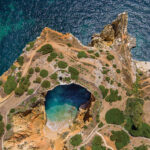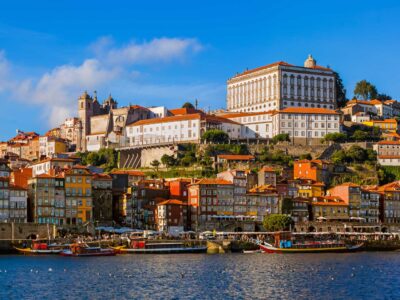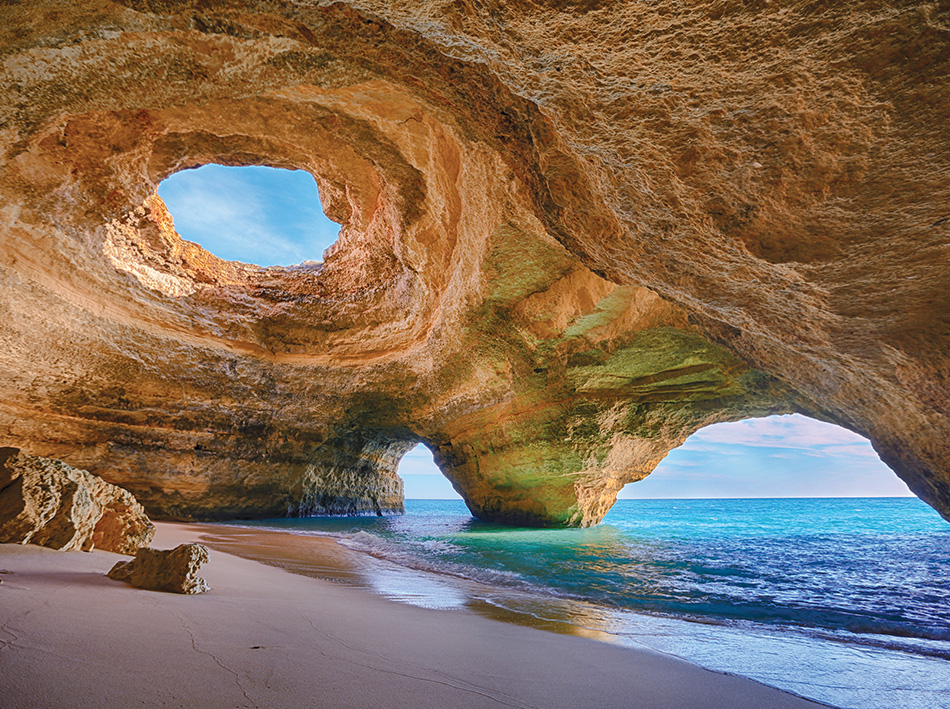
The best beaches of Portugal can be found in the Algarve (PC: Bruno Carlos)
Though both are part of the Iberian peninsula, a few things appear remarkably different as soon as you cross the border on the road from Spain to enter Portugal at the peninsula’s on the southern-most tip. Perhaps the first thing the motorists would notice the language on the road signs, which switches to Portuguese and second is that petrol is distinctly cheaper in Portugal than even in Spain, which itself is a lot cheaper than France or Germany.
But beyond the road signs and fuel prices, it is the change in landscape that is remarkable. But to see that in a clearer fashion, leave the Autoroute A49/A22 and head south to take N125, for it is on these smaller routes that a road-trip’s best kept secrets appear. And Portugal is no different in this manner. First thing is that you are closer to the beach, which is as stunning as on the Spanish side of the border, if not more.

Faro city centre has several pedestrian-only zones where restaurants offer delicious Portuguese cuisine (PC: AT Alagrve)
The Algarve: Portugal’s tourism magnet
After all you are in the Algarve, one of the most historic and beautiful regions of Portugal that is as rich in natural beauty as in the mixed European and Arab heritage which is one of the distinctive elements of the two Iberian countries. No wonder then that the Algarve attracts the most number of tourists in Portugal, with over 5 million visitors in 2019, over a third of total number of tourists visiting the country in that year.
Though it is a small region, just over 4,500 sqkm in area, Algarve is remarkably diverse which makes it a pleasurable destination where one can spend over a fortnight and yet have distinctively different activities and sights almost every single day. Each of the 16 municipalities of Algarve comes with its own landscapes, history and perhaps even a bit of local flavour in the culture. The capital Faro, for instance, is best known for Ria Formosa lagoon, a large natural park, one of the most important sites for bird watching in Europe where birds from the Arctic region migrate during the winter. Not too far away, Lagos is remarkable where you can see the sculptures made over thousands of years as waves of the Atlantic Ocean crash into the landmass, leaving thousands of unique rock formations, each distinct and each as eye-catching as any other.
One of the best places to see these formations is Ponta da Piedade, a long series of orange and yellowish, sandstone cliffs that are considered the finest natural landmarks of this part of the Algarve. One can take at least a couple of hours to explore these sights.
Another town, Lagoa offers ochre cliffs surrounded by warm turquoise sea and just a slight bit inland, long stretches of vineyards that produce some of the most famous Portuguese wines. Besides natural beauty, Algarve has hundreds of well-preserved monuments and forts that date back to the Middle Ages when this region switched hands from Christians to Islamic and then back to Christian rule. It was part of the greater Al-Andalus region, of which a large part is today’s Andalusia in Spain.

Lagoa in Algarve has natural marvels of sea sculptures (PC: AT Alagrve)
Sines: Vasco da Gama and Surfers
As you leave Algarve and head northwards, again hug the coast and see some of the sights that you are bound to miss by taking the autoroutes which of course are faster. Barely 120 km north of Lagos is Sines, a small seaside town on the Alentjo coast, which has two claims to fame. First, it is the birthplace of Portuguese explorer Vasco da Gama and second that it boasts of some of the best surfing sites in the western world.
To Indians, Vasco da Gama needs no introduction as he was the first European to arrive in India by sea in 1498. Sines pays homage to its most famous son with a large statue of the explorer just next to the west tower of the town’s castle. The statue was erected in 1970 to mark the 500th anniversary of his journey to India.
Sines is also well-known, amongst the global surfing community, for its breath taking kilometres of sandy beaches and wild, untamed waves that makes it the perfect coast for surfers. The beaches of Morgavel, Vale Figueiros, São Torpes, Praia Grande do Porto Covo, and Ilha do Pessegueiro, all in and around Sines, are the most popular of the Sines beaches for surfers and also frequently win European Blue Flags for cleanliness.
From Sines, as you continue northwards towards the capital Lisboa, which is about 160 km away, you hit Setubal, site of another natural wonder. About 40 km south of Lisboa, Setubal is located on the edge of the Setúbal peninsula, on the north bank of the Sado estuary.
It is one of the most important agricultural production sites in the country, which find mention in historical documents that date back to the 14th century. It is especially well-known for its grapes, wine, oranges and fish as Setubal is an important seafaring city in a country that has a long history of seafarers. Setubal’s wines have now attained global repute, especially the eponymous muscatel, Setubal, which is grown in abundance in the vineyards here.
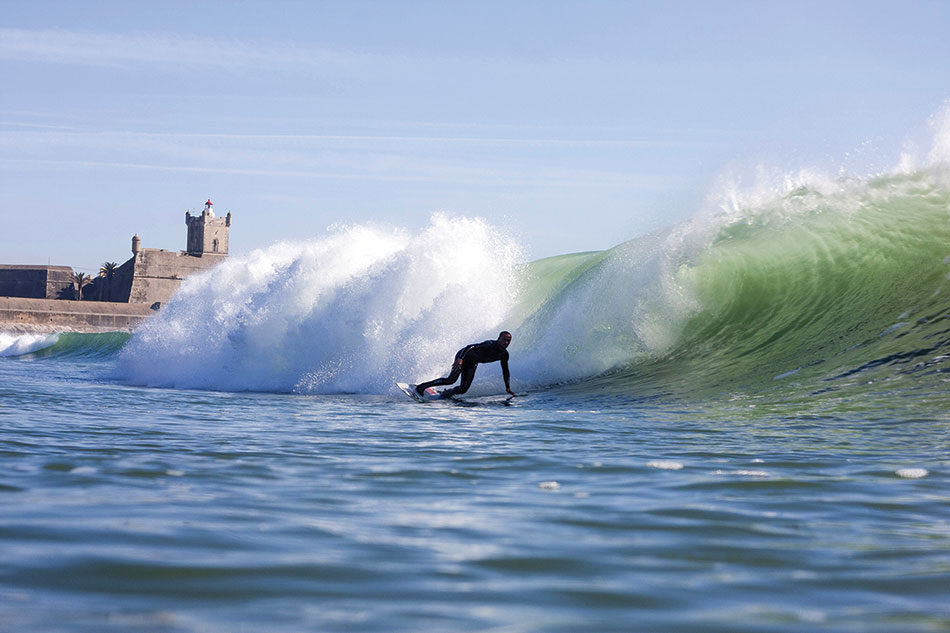
Portugal is a surfer’s paradise (PC: Andre Carvalho)
Setubal also boasts of Fort of São Filipe, a 16th century fort that has been converted into a hotel and it is worth a visit, even if you are not staying here as it offers the best views of the city and the area around it, notably River Sado, Tróia and the Arrábida mountain range.
Another attraction for tourists to visit Setúbal is that around the city there are several nature conservation areas, in particular the Sado Estuary Nature Reserve, where you can watch dolphins in the wild. Another site worth a visit is the Arrábida Natural Park, which has unique characteristics and contains species that can only be found in areas near the Mediterranean.
Setubal is also home to many excellent beaches, especially Figueirinha, Galapos and Portinho da Arrábida, which is a unique sheltered bay. Across the River Sado, lies the Tróia peninsula that comes with several km long beaches and a golf course. Frequent ferries can take you across the river to this idyllic spot.
Lisboa
Lisbon or Lisboa as the capital is called in Portuguese, is not only the most important city in Portugal, but its historic importance and cultural vibrancy has also made it one of the most visited cities in Europe. Dating back to the Roman era and having seen its peak during the Portuguese colonial days, when the country rivalled or even beat other European nations in wars, Lisbon as we know it is mainly from the late 18th century as the city centre was reduced to a rubble in a major earthquake in 1755.
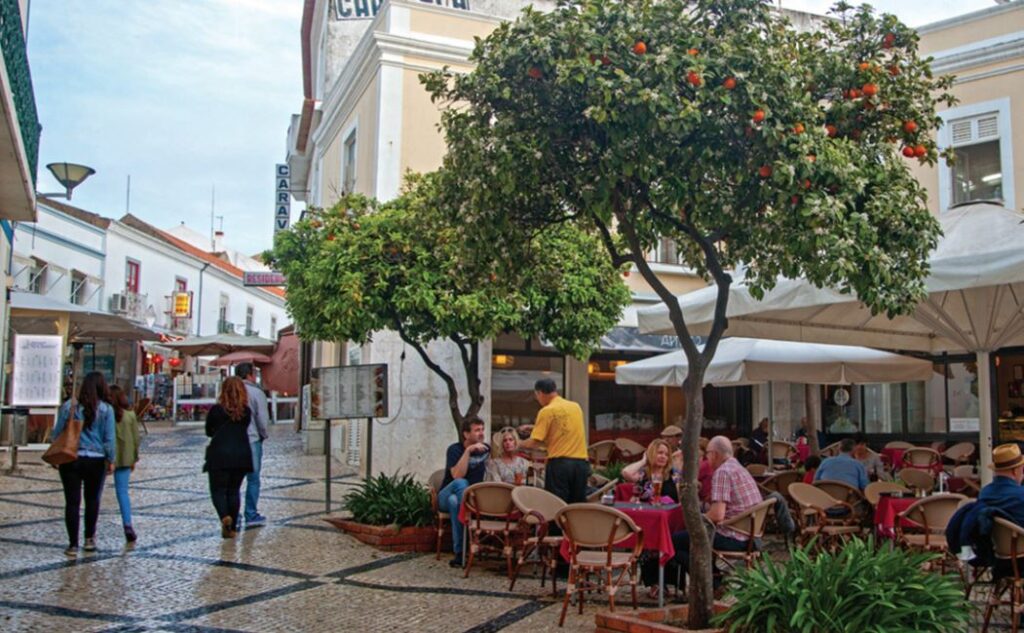
With sunny spring and summers, outdoors are best enjoyed in Portugal (PC: AT Alagrve)
Though reconstructed soon afterwards, Lisbon got a comprehensive makeover in the early 1990s as it was designated the European Capital of Culture in 1994 and also hosted the Exposition 1998, one of the biggest global events. So many landmarks of today, like the Vasco da Gama Bridge and construction of a mini city along the Tagus River, with oceanariums, marinas, hotels, commercial complexes, and theatres.
However, even though modernised, Lisbon retains a certain charm about it, with fish vendors carrying their fresh catch in baskets on their heads to the market.
The city has historic cobbled paths and striking tiled facades of the 18th century style buildings that line the historic suburbs of Alfama and Mouraria, which are located on a steep hillside which can be traversed either on the famed trams or even better, on foot as it is only by walking around that a visitor can get to see the most wonderful sites that Lisbon has.
But since a visit to Lisbon can never be complete without a tram ride, take the route 28 of the tram which offers the best views of and from the city. Built in 1914, the Tram 28 route connects the central district of Baixa through Graca and Estrela, further to other charming neighbourhoods.
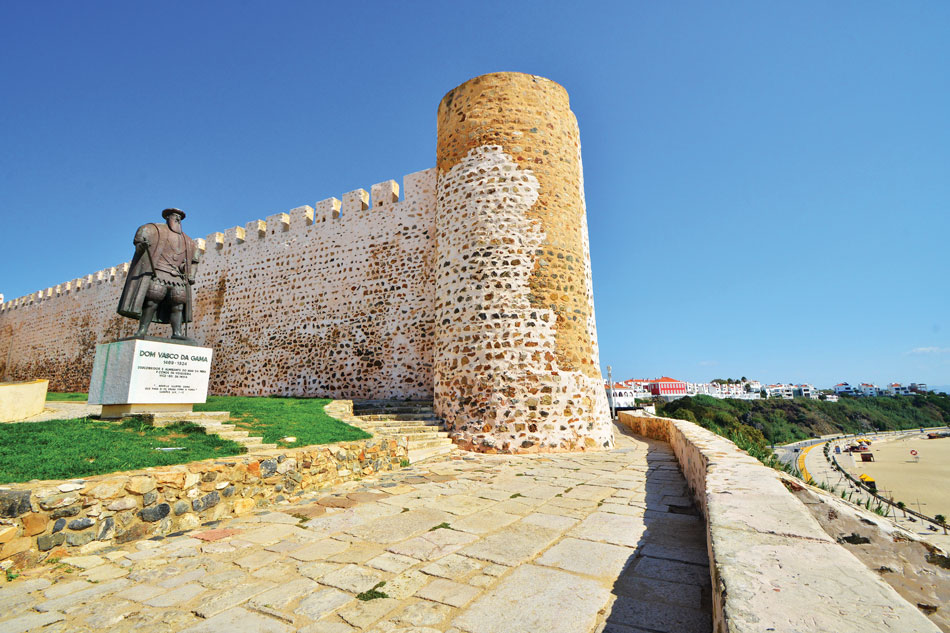
Sines pays homage to its most famous son, explorer Vasco da Gama (PC: Turismo Alentejo)
One of the unmissable sights is the Abbey of Alcobaça, which is one of Europe’s most important Cistercian abbeys. It is a UNESCO World Heritage, thanks to its excellent conservation and its architecture, that is symbolic of the order. Arco da Rua Augusta is one of Lisbon’s iconic buildings and one should climb it for a unique view of the city. But perhaps the best view of the city is from Belem Tower, built in the early 16th century and designed to serve as both a gateway to the city of Lisbon and as a defence against possible invasions and attacks from the Tagus.
Just beyond Lisbon is Sintra, in the hills of the Serra de Sintra. It is home to another man-made wonder, a UNESCO World Heritage Site that brings together a palatial complex, with notably the Vila Palace with its two distinctive cone-shaped chimneys, the Palácio and Quinta da Regaleira and the Pena Palace.
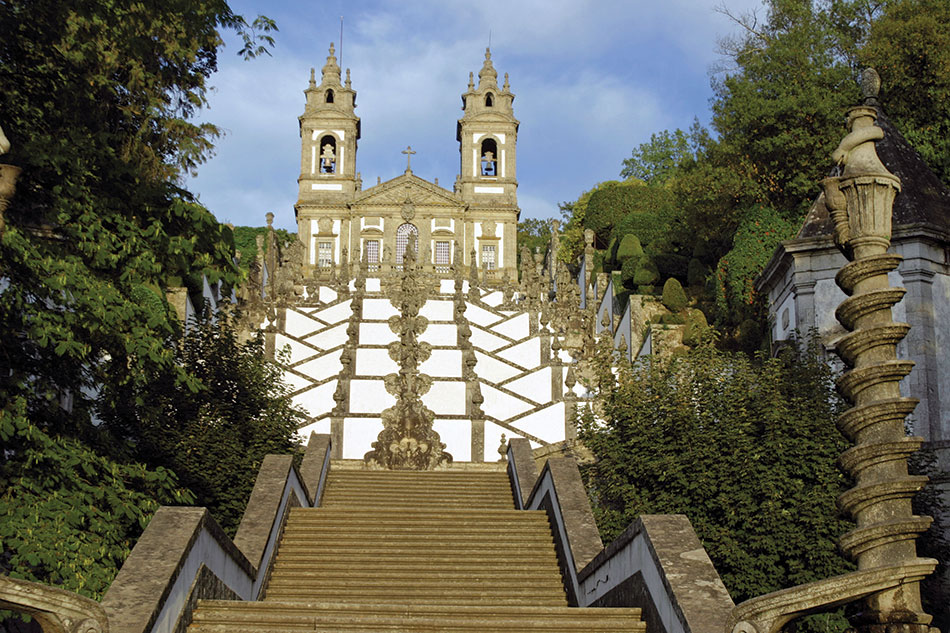
Bom Jesus do Monte Sanctuary Braga (PC: Porto Convention & Visitors Bureau)
Porto
About 300 km north of Lisbon is the second largest city of the country and one that lent its name to the country, Porto or Opporto. Established by the Celts on the mouth of the Douro River, it was occupied by the Romans during the fourth century, who transformed it into an influential commercial port and renaming it “Portus Cale”.
Porto is best known for its stately bridges and the eponymous wine, Porto or port wine. The city’s medieval Ribeiraor riverside district, narrow cobbled streets wind past merchants’ houses and cafes. One of the most famous buildings here is the São Francisco Church that is known for its lavish baroque interior with ornate gilded carvings. Another landmark here is the palatial 19th-century Palácio de Bolsa, formerly a stock market, that was built to impress potential European investors. And of course, do not forget to visit one of the many vineyards that produce Porto, not just to sample but also take back home with you.
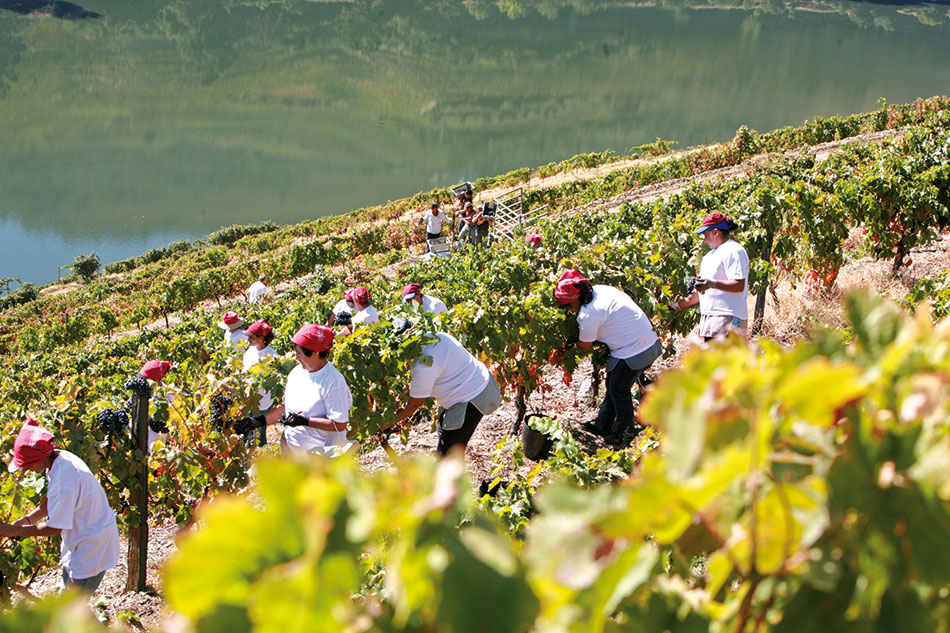
Douro Valley produces Portugal’s best-known wine (PC: AT Porto and the North)
Braga
About 55 km north of Porto and almost on the northern edge of Portugal is the holy city of Braga that attracts tourists and devotees from all over the world. It is known for its religious heritage and events. In one sentence, Braga is a collection numerous holy sites that are linked to the Catholic Church and which were perhaps at the origin of several missionary orders that have spread out across the world.
One of the best known religious sites here is Bom Jesus do Monte complex that has a neoclassical church atop an elaborate 17-flight stairway. Another location worth a visit is the Porta Nova Arch, which was the entrance to city for the Kings and Archbishops and was opened on the wall surrounding Braga in the early 16th century, at the initiative of Archbishop D Diogo de Sousa. It is one of the biggest allegories of the city, seen as a sort of welcome to all those who visit Braga.
The Tower of Menagem was part of the old Castle built by D Dinis. It has been classified as a National Monument since 1910, and since 2017 it has been an interpretive nucleus of Braga’s history, where the whole history of the city can be consulted.
In the city centre, the Braga Cathedral, dating back to the 15th century, is home to a sacred art museum and the Gothicstyle Kings’ Chapel. Nearby, the imposing Archbishop’s Palace overlooks Santa Barbara Garden.








